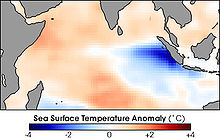Indian Ocean Dipole
The Indian Ocean Dipole ( IOD ) denotes a naturally occurring anomaly of sea surface temperature (Engl. Sea-surface-temperature, hence short SST anomaly) on the equatorial eastern and western end of the Indian Ocean (Indian Ocean). It accounts for about 12% of the total temperature anomalies of the Ind.
A strong IOP event is spoken of when the western area of the Indic near the equator is warmer and the eastern part of the Indic near the equator is cooler than normal, which has far-reaching consequences in the coupled ocean-atmosphere system. This phenomenon was discovered for the first time in 1999. This system is based on a cycle duration of around 30 years, in which positive, negative and neutral phases alternate in half-year cycles. Similar systems are also known in the other two oceans, the Atlantic ( Atlantic Multi-Decade Oscillation ) and the Pacific ( Pacific Decade-Oscillation ).
Effects
The effects of this sea temperature anomaly are quite diverse, especially in relation to the Indian monsoons . In the event of a positive IOP event, less precipitation falls on the west side of the Indian subcontinent due to the reduced sea-land temperature and thus also the pressure difference, which in turn is more pronounced on the east coast and more precipitation falls here.
The IOD divides the Indic into two regions, the Indonesian-Australian, which is to be regarded as belonging together, and the east coast of Africa. In these two regions, a non-neutral phase always results in a phase that is opposite to the other region with low or high rainfall. The distribution of precipitation does not depend on the monsoonal winds as in India, and therefore not on the land-sea temperature / pressure difference; Australia and Indonesia and the equatorial part of East Africa are so close to the equator that the existing pressure conditions (see Hadley Cell and Inertropical Convergence Zone ) do not depend on the land-sea temperature differences and precipitation is simply via evaporation and convection over the sea is controlled. As a result, a regional drop in sea surface temperature (SST) results in less convection over the sea and therefore less precipitation, which increases the likelihood of a drought. In the event of a positive event, there is a lower SST in front of Australia and Indonesia and therefore less precipitation, while in equatorial East Africa there is an increased SST and thus more precipitation, a negative event, on the other hand, always has exactly the opposite consequences.
Interactions with El Niño-Southern Oscillation
Since the El Niño-Southern Oscillation (ENSO for short) index is mostly defined by the difference in air pressure between the Indonesia low pressure area and the high pressure off the Peruvian coast, interactions are not surprising, as the Indonesian low is also a sub-element of the IOP. A positive IOP event can be triggered by a positive ENSO event, but an IOP event can also trigger a positive ENSO event, but the internal variability of this system also allows different phases to occur without external influences. The existing teleconnections work via the atmosphere, so a positive IOP phase can cause a negative SST anomaly (due to upwelling ) off Indonesia and, with the associated pressure drop, a positive ENSO event.
literature
- Nature: Seasonal characteristics of the Indian Ocean Dipole during the Holocene epoch. 2006. Nerilie J. Abram, Michael K. Gagan, Zhengyu Liu, Wahyoe S. Hantoro, Malcolm T. McCulloch and Bambang W. Suwargadi.
- Nature: A dipole mode in the tropical Indian Ocean. 1999. Saji NH, Goswami BN, Vinayachandran PN, & Yamagata T.
